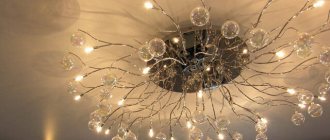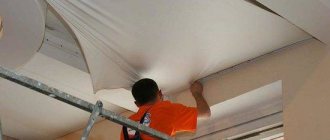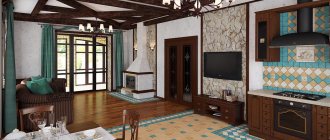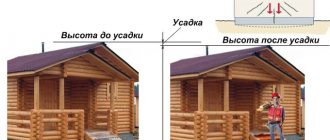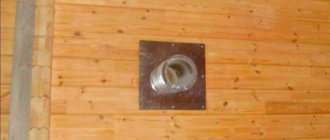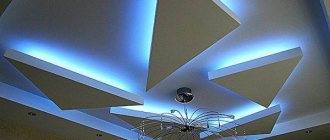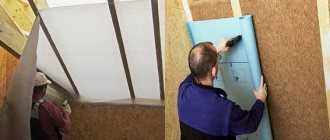In city apartments and office premises, stretch ceilings look quite familiar. This finishing material has gained great popularity due to its ease of installation and richness of colors. Such properties allow you to realize the most daring design solutions. Stretch ceilings in a private house built of wood began to be installed relatively recently. This is explained by the operational features of such buildings.
Is it possible to make suspended ceilings in a wooden house?
It is allowed to install tensile structures in wooden houses, but when performing the work it is important to observe the subtleties of the technological process. Installation is no different from installation in a city apartment. The difficulty lies in the operating features of a structure made of wood.
You should not install a suspended ceiling in a recently built wooden house. Over time, as a result of shrinkage, the geometric dimensions of wall and ceiling ceilings will change and waves will form on the panel.
You can begin finishing the ceiling only 1.5-2 years after completion of construction.
Materials made from polyvinyl chloride film are subject to cracking when exposed to negative temperatures, so PVC sheets cannot be installed in unheated buildings.
The harmful effects of dampness on fabric ceilings lead to the destruction of their color and loss of aesthetic appearance. In addition, the material that has absorbed moisture quickly becomes moldy, so such finishing is not recommended in unfinished log houses and unheated wooden buildings. When installing suspended ceilings, you should understand their pros and cons. Let's look at the main advantages and disadvantages.
Types by method of fastening
Mortgages for lamps for suspended ceilings are of two types:
- fixed;
- universal.
Fixed ones are selected individually for the specific size of the lighting fixture. Their cost is cheaper, but when replacing a lamp, you have to select a new model with the same diameter as the old soffit. Otherwise, difficulties arise during re-installation.
Universal ones are more common due to the fact that they are suitable for installing most chandeliers and spots. During installation, part of the plastic is cut off, leaving a hole of the required diameter.
Pros and cons of this solution
Positive qualities include the following:
- simplicity and speed of work;
- no need to level the ceiling surface;
- protection of the renovated room from water leaks from above;
- ease of care of the coating;
- incredible variety of colors and textures;
- masking ceiling defects and the ability to hide communications.
Well-installed tension coverings, with proper care, will serve their owners for more than 15 years without loss of performance characteristics. The perfectly smooth surface retains the brightness of the colors and does not sag or crack over time.
The disadvantages include:
- the possibility of surface deformation in an unheated room;
- the risk of accumulation of condensed moisture vapor, mold and infection of ceiling beams by pathogenic microflora;
- slight vibrations of the material when a draft appears;
- cuts from sharp objects make it impossible to repair the finish;
- Rodents can live in the space between the ceiling and the tension fabric.
By following the rules of operation and installation, you can avoid the manifestation of most negative qualities. This circumstance is confirmed by practical experience in the use of tensile structures by owners of log houses.
Choice of fabric depending on temperature conditions
The canvas for suspended ceilings is made of polyvinyl chloride film or synthetic fabric. The choice of material largely depends on the temperature conditions at which it will be operated.
PVC film is subject to thermal expansion and contraction, this circumstance negatively affects its performance characteristics. In addition, if the temperature drops sharply, the stretched fabric may crack to the point of being unusable. As a result, further use will be impossible and the material will have to be completely changed.
The operating temperature of PVC sheets ranges from +5 to +50°C. As a result, it is advisable to use polyvinyl chloride film for arranging a stretch ceiling only in year-round heated buildings.
Owners of country houses with seasonal residence should prefer fabric. It is significantly less susceptible to thermal expansion and can be operated without loss of performance characteristics at temperature fluctuations from -50 to +40°C. Therefore, only fabric stretch ceilings can be installed in a country house or village house.
When installing PVC film with your own hands, it is important to consider that the material requires heating to 70°C. To do this, you need a heat gun, which in inexperienced hands can damage the wooden ceiling. There is no need to heat the fabric ceiling during installation; it is easier to install it yourself.
Useful tips
If a suspended ceiling is already installed in the room, be careful when assembling the furniture. Ceilings are easily damaged by sharp edges and objects.
If there is a small gap between the wardrobe lid and the suspended ceiling, you can use a ceiling plinth. You will get a feeling of the integrity of the structure.
Don’t be lazy to calculate all the dimensions at the planning stage, before purchasing furniture. A few centimeters can become critical when installing a wardrobe or ceiling.
If you are making the ceiling first, be sure to inform the craftsmen of your intention to install a wardrobe. Perhaps they will give you useful installation advice and take your wishes into account when installing the ceiling. You should also express your wishes when installing a wardrobe.
How to make a suspended ceiling yourself
First of all, it is necessary to take into account the functional purpose of the room in which the tension fabric will be used and prepare it correctly. There are nuances to performing the work if the building is built of timber or has stove heating. The technology for installing a tension structure on a ceiling with beams is also slightly different. In addition, it will be necessary to solve the problem of condensed moisture vapor, which has a destructive effect on wooden floor beams. Let's look at each situation in more detail.
Features of preparation
In general, the preparatory stage includes the following actions:
- Check the integrity and, if necessary, repair roof leaks. Atmospheric moisture that has leaked through the roof will not break through the stretched fabric, but will require regular removal of water and drying of the material.
- Treating the rough ceiling with agents that prevent the development of pathogenic microflora and fire retardants that prevent fire. After installation is completed, these manipulations will not be possible.
- Extermination of rodents and insects. Otherwise, mice, cockroaches, ants and other living creatures will settle in the space between the panel and the ceiling. To do this, you should also cover all cavities.
- Arrangement of high-quality ventilation to prevent wood rotting and mold formation, since the stretched fabric prevents the free movement of air masses.
- Drawing up a diagram of the location of lamps and laying electrical wiring.
If the house is made of timber
Installing suspended ceilings in a timber house requires highly qualified performers of this work. If the building is made of profiled timber, there will be no problems. The installation difficulties lie in the difficulty of attaching a flat profile to the rounded surface of a rounded log.
If you fix the baguette in the middle of the beam, then on the other side at this level there will be a joint of the logs. In addition, you will need to cut the profile at a complex angle and glue the joints. To facilitate this work, a flat base of lumber, such as boards or OSB, is constructed around the perimeter of the room. The resulting gap will be closed by installing a wooden ceiling plinth.
If the house has a stove
If there is a stove in a log house, you will need to do the following:
- Place a plasterboard box around the chimney. The air gap between the chimney and the gypsum board will protect the tension fabric from overheating and melting. Additionally, you can use a coaxial chimney. It has a double pipe design and produces less heat.
- Install a mortgage to securely fix the profile to the drywall. A block is screwed onto the inside of the gypsum plasterboard box, to which a baguette for the stretch ceiling is subsequently attached. If this is not done, when the canvas is tensioned, the profile will tear out of the plasterboard, since the fragile gypsum structure of the material is not designed for such loads.
The operation of the stove is associated with the formation of smoke and soot, so the ceiling will have to be washed more often. Contaminants are easily removed from the surface of the stretched film with mild detergents dissolved in water. Do not use aggressive compounds, including abrasive particles and acids, for cleaning, as they can seriously damage the coating.
Solving condensation problems
To prevent the negative effects of moisture, the wood is impregnated with compounds that prevent the formation of mold and mildew. Since PVC film does not allow air to pass through, natural or forced ventilation is installed. Grates are installed in diagonally opposite corners to reduce the pressure difference and thus prevent the accumulation of vapors. Additionally, it is recommended to install a ceiling exhaust fan.
In rooms with high humidity levels, in the kitchen or bathroom, installing film ceilings has positive aspects. Moisture will be deposited on the surface of the canvas without penetrating the wood structure.
What is a mortgage, why and how is it installed?
The embedded material is chipboard, a wooden or aluminum beam of appropriate thickness, usually in the shape of the letter P. It is mounted to the ceiling slab using dowels in the place where the cabinet is planned to be installed.
This part takes on all the loads associated with fabric tension and is not afraid of mechanical stress. The canvas can be joined to it at any level; this depends on the choice of room design by the owner or hostess. The cabinet is mounted directly to the same beam. The peculiarity of such a system is that:
- compartment panels are not subject to additional loads;
- the canvas is secured securely and at any height within this beam;
- The embed can be made in the form of a decorative visor, if that is what you want.
- Also, the beam can be made in dimensions exceeding the dimensions of the compartment, and baguettes for hanging fabric in this case can be mounted both on the facade and below, and even on the reverse side facing the door guides. In this case, the hanging canvas can partially or completely cover not only the top panel of the compartment, but also the upper door guides.
And finally, the promised exception to the rules - there are two options when a mortgage is not needed:
- the material of the furniture panels is strong enough to safely withstand the tension of the ceiling;
- the canvas is stretched along the entire perimeter of the room, the furniture is mounted below.
In this article, we briefly described the purpose and options for using (and not using) the mortgage, as well as attaching the canvas to it. What to choose and how to implement it is up to you to decide.
Installation technology
The main stages of installing a stretch ceiling:
- Cleaning walls and ceilings from dirt, treating surfaces with protective agents.
- Determining the location of lighting fixtures, installing mortgages and supplying electrical wiring.
- Marking and fastening profiles at a distance of about 10 cm from the rough ceiling. The baguette is screwed with 6x50 wood screws or universal galvanized screws with a pitch of 10-15 cm.
- Warming up the room with a heat gun and tensioning the fabric. The film is tucked into the baguette starting from the corners and gradually moving towards the center. Fabric ceilings do not require heating and are stretched from the middle of the walls to the corners; upon completion of the work, the remaining fabric is cut off with a knife.
- Installation of lighting fixtures. In places where spotlights are installed, special thermal rings are glued to the canvas, protecting the film from tearing and overheating. Next, a hole is cut inside the tread ring and a lighting fixture is attached to the insert.
- Sealing of butt joints. The places where the baguettes adhere to the wall are covered with decorative tape, masking the installation joints.
Features of installation in a house with beams
If the design project provides for the external location of the beams, the installation of the tension fabric has some features. There are two ways to make wooden beams on the outside of the finish:
- The canvas is stretched over pre-installed base beams. Decorative false beams are installed on top.
- The stretch ceiling material is fixed in the spaces between the beams. To do this, it is divided into fragments of the required configuration.
It is much easier to do the work using the first method, but if the ceilings are low, it is not recommended to use it, since the usable area of the space is reduced. The second method is more complicated to implement, but can be used in any room.
What to consider during the construction phase
When planning the installation of tensile structures in a wooden house, it is recommended to provide for all the nuances of subsequent operation during the construction stage:
- The height of the ceilings is selected taking into account the characteristics of the decorative coating.
- Roof waterproofing work is carefully carried out to prevent the infiltration of atmospheric moisture.
- To avoid the appearance of fungus and mold, ventilation is provided. Additionally, the wood is impregnated with compounds that prevent the development of pathogenic microflora and fire.
- To prevent rodents from settling in, cracks in the sub-ceiling are carefully sealed and devices are installed to repel them.
- Measures are taken to prevent construction dirt from falling off the rough floor, otherwise, after the film is tensioned, debris will fall onto the canvas. To remove it, you will have to dismantle the ceiling.
- At the construction stage, a thermal frame is immediately installed around the chimney pipes from the fireplace or stove.
In conclusion, it can be noted that stretch ceilings, which have recently appeared on the modern construction market, are gaining increasing popularity as a finishing material. The advantage is determined by the high performance qualities of the decorative coating, its long service life, resistance to moisture and ease of surface care. Like any building material, tensile structures have pros and cons, but the advantages far outweigh the disadvantages.
If the roof is leaking
If the roof covering is damaged, rain and melted snow will collect on the inner surface of the stretch ceiling, from where the liquid can be collected in a separate container. To do this, the repair team unfastens the edge of the structure, drains the water, dries the canvas and pulls it back.
Important! It is natural for a tree to draw water onto itself. Therefore, drying takes longer. If you stretch the ceiling under a damp attic or interfloor ceiling, then the appearance of mold is inevitable.
Film ceilings can retain liquid for several days without losing their properties, fabric ceilings can hold liquid for 2-3 hours and immediately become unusable. Paint designs on canvas made of polyester threads may blur even if over-moistened.
The presence of ventilation grilles violates the tightness of the structure. In order not to lose the valuable property of PVC ceilings to retain water, it is worth considering other air exchange options.


